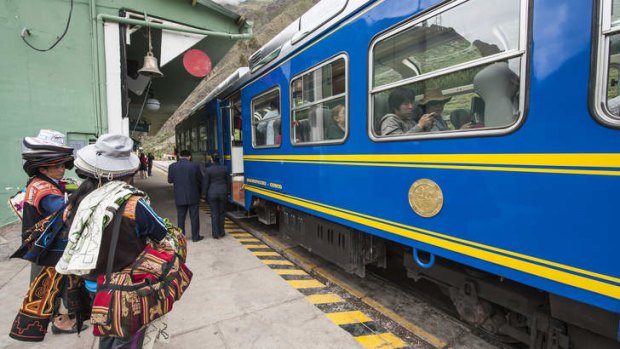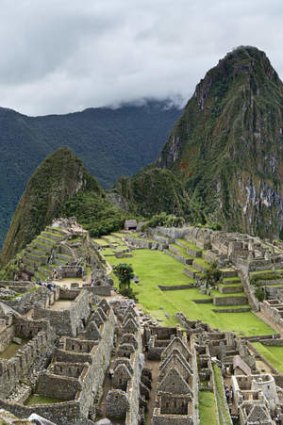This was published 9 years ago
Machu Picchu: Top of the world

An Inca souvenir vendor at Ollanta train station in Ollantaytambo.Credit: Getty Images
Machu Picchu surpasses even its reputation, writes Garry Maddox.
In the early morning sun, the PeruRail express to Machu Picchu rolls through the Sacred Valley of the Incas.
Outside are lush rainforests, rugged mountains and steepling waterfalls. Passengers - Australians, Spanish, Germans, Americans - chatter about the landscape and their visit to the fabled lost Incan city.

Seeing is believing: Machu Picchu.Credit: Getty Images
But there is one sight inside the carriage that is almost a tourist attraction in its own right - oblivious to the scenery, three young Japanese women are turning an extended make-up session into performance art.
Using a kit that could pass for an overnight bag, they work intensely on their faces, swapping seats, passing around a hand mirror and, when that's required elsewhere, using a handy smartphone app that turns the screen into a mirror.
When it comes to visiting Machu Picchu, there are two choices - the trail or the train. It's a decision between trekking four days on the famous Inca Trail, taking in stunning landscapes and pre-Columbian ruins, or sharing a carriage for 90 minutes with travellers from around the world.
Ideally, getting the trekking gear and hiring a porter would be the way to go. But if you don't have the fitness, the enthusiasm or the time, you can stay in the historic city of Cusco, or the even closer town of Urubamba, and see Machu Picchu on a day trip.
Given that it is Latin America's most-visited tourist attraction with more than 400,000 visitors a year, PeruRail is a popular option.
So here we are at Ollantaytambo's railway station in the morning. We have been shuttled from a hotel too luxurious for a brief overnight stay - the Belmond Hotel Rio Sagrado - on the banks of the Urubamba River.
The alarm was set for 4.30am, which meant leaving the lawns with baby llama and alpaca and the room's private terrace that were barely glimpsed before dark the previous day.
Aboard, the train seats are comfortable, the windows panoramic enough to take in the landscape, and the staff wheel around a light breakfast and snacks. Like a scene from Woody Allen's Manhattan, we pass a train headed in the opposite direction. Except that our carriage is filled with affluent Westerners, theirs packed with exhausted Peruvians who were apparently returning from shifts at a hydro-electric plant, although someone suggests they had the thousand-yard stares of porters who had finished helping tourists along the Inca Trail and were heading back to start again.
It's one of those moments that highlights the privilege of the tourist compared to the tough daily lives of the locals.
Arriving at the touristy town of Aguas Calientes, we buy water and fruit at a market by the railway station ("they'll be five times the price on the mountain", cautions Celina, our guide for the day) and join a longish queue for a 20-minute bus ride up the mountain, a trip occasionally made dicey by buses hurtling down the narrow road back to town.
On first sight, Machu Picchu is even more striking than its reputation suggests - not just the ancient stone buildings on a remote mountain ridge surrounded by rainforest, but also the sheer size. It's a Sunday, so Peruvians can enter the World Heritage site either free or cheaply, and there must be 2000 people wandering around. But from a lookout, it looks barely populated.
"Would anyone believe what I have found?" the American explorer Hiram Bingham wrote in his diary in 1911. He had been planning to climb Mount Coropuna when a landowner in Cuzco, 80 kilometres away, told him about ancient constructions covered by vegetation on top of a mountain.
Travelling to the area, Bingham met two farmers who were working the Incan terraces and was led by a child to the old citadel that he soon made famous in an edition of National Geographic.
During excavations, most of the artifacts - pottery, metal work, human remains — were shipped to Yale University, where Bingham lectured, so the site has few of the reminders of daily life that Pompeii, for example, has.
"The Incas built here for three very important reasons - location, location, location," says Celina, suggesting that the wise ancients knew as much about real estate as they did stonemasonry, irrigation, architecture, technology, science and agriculture. "Location means privacy and security."
Celina, who has visited Machu Picchu more than 800 times in 15 years, says the location also gave the Incas plentiful water, which was important since the site had an agricultural area as well as ceremonial, domestic and manufacturing buildings.
Learning a little of Machu Picchu's history raises the mysteries that surround the fortress - the Incan emperor Pachacutec is believed to have built it in the 15th century, as a private estate for nobles, an agricultural project or, as Bingham thought, a refuge for rebel Incas.
"The people who were living here were the virgins of the suns, the concubines of the Inca, the most powerful man in the empire," says Celina.
It was abandoned when the Spanish conquistadors carved up the empire, possibly because smallpox had wiped out the indigenous population.
According to Celina, knowing the aliens had arrived, the Incans abandoned their citadel and withdrew into the jungle.
"We were very unlucky," she says with feeling, "first Pizarro, then the American boy."
The construction of these dry-stone buildings, including the Temple of the Sun, Priest's House, Royal Mausoleum and Royal Residence, still seems remarkable.
As Bingham wrote: "Still amazed, I began to realise that this wall and the adjacent temple were as fine as the finest stonework of the Old World. What could this place be? ... The walls, made from white granite, featured massive stone blocks, taller than a man. The sight of that clearly mesmerised me."
If the atmosphere is generally respectful around the site, there are also carnival touches this day. Colombian teenagers ham it up for the camera, Australian seniors dart up rock stairways like mountain goats, Americans gush over a paddock full of llamas, a colourfully dressed Peruvian mother and two straggly children pose for photos in return for coins, and nuns file quietly along a pathway. Every now and then, a security guard shouts at a tourist who strays into a roped-off area.
Heading for the exit, the three young Japanese women from the train, having taken their time, are just arriving. Their make-up, though, is perfect.
The writer travelled courtesy of LAN and Adventure World.
TRIP NOTES
GETTING THERE
LAN Airlines has seven 23-hour flights a week to Lima via Santiago. You can connect to Arequipa or Cusco. Phone 1800 558 129, see lan.com.
Adventure World has a two-day/one-night tour of Machu Picchu and the Sacred Valley from $893 a person including accommodation and return train journey. See adventureworld.com.au.
STAYING THERE
Belmond Hotel Rio Sagrado at Urubamba has rooms, suites and villas from $US255 ($275) a night. See belmond.com.
Sonesta Cusco Hotel, Avenue El Sol 954, has 70 rooms from $US133 ($143) a night. See sonesta.com/cusco.
Belmond Hotel Monasterio, Cusco, is a former monastery that has 126 rooms and junior, presidential and royal suites from $US265 ($285) a night. See monasteriohotel.com.
EATING THERE
In Aguas Calientes, Sumaq Hotel, Avenue Hermanos Ayar Mz 1 Lote 3, has an excellent restaurant that marries traditional Peruvian with modern international dishes. See machupicchuhotels-sumaq.com.
MORE INFORMATION
Sign up for the Traveller Deals newsletter
Get exclusive travel deals delivered straight to your inbox. Sign up now.